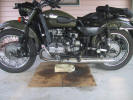
Place an oil catch under the engine sump and... |
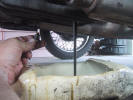
...drain the oil. Replace drain plug.
If you have a deep sump installed you
must remove it in order to clear the frame. It would be wise to
install the standard sump to protect the oil pump during engine
removal or installation. |
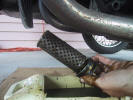
Remove filter and drain oil from filter sump. Replace
filter and re-install. |
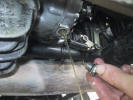
Place oil catch under gear box sump and drain oil.
Replace oil drain plug. |
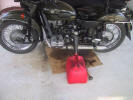
With petcock in "Off" position, pull fuel line from
left carburetor and place line in drainage container. Turn petcock
on and drain fuel from tank. |
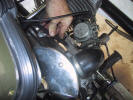
When fuel tank has drained, remove right carburetor
fuel line at carb. |
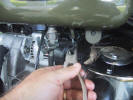
Use pliers or large screwdriver blade to work one end
of the fuel cross-over tube free.
Use caution as residual fuel will
spill out. |
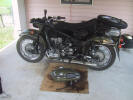
Remove fuel tank. Refer to Chapter 9.2 |
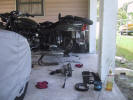
Remove rear wheel (Chapter 2.6) and remove final
drive as shown in Chapter 7.2. |
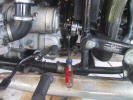
Use a large flat blade screw driver or pry bar to... |
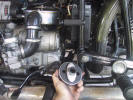
...remove the rubber flex coupler. |
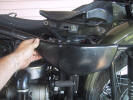
If installed, remove the decorative side cover.
|

Turn the master battery switch to the "Off" position
or disconnect the battery as applicable. |
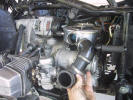
Use a screw driver to loosen and remove the left and
right branch tubes. |
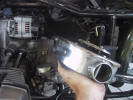
Use a 13 mm wrench and 8 mm Allen wrench to remove
the air filter housing. Refer to Chapter 9.4. |
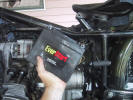
Remove battery. Refer to Chapter 8.3. |

Use a 13 mm wrench to remove all wires from the
starter solenoid. Do not forget the small spade push-on wire on the
back of the solenoid (just visible below nut & stud). |
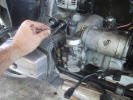
Remove left & right carburetors at the compliance
fittings, in this example, a 3 mm Allen wrench is needed. |
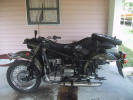
Place both carburetors up out of the way. Draped over
the handle bars or resting over the hack are safe places for the
carbs. |
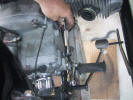
Use a 13 mm wrench to remove the neutral switch
indicator wire.
Place or tie it off so it will not
get damaged during engine removal and replacement. |

Use a 13 mm wrench to loosen the lock nut on the
forward clutch adjustment bolt and remove it from the bracket.
The bracket will be needed if you
are installing a new factory engine. |
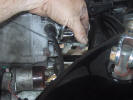
Use the 13 mm wrench to loosen the lock nut on the
aft clutch cable adjustment screw and remove it from the clutch
release arm.
Place or tie off the clutch cable
so it will not get damaged during engine removal and replacement. |
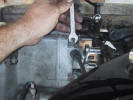
Use a 10 mm wrench to loosen the speedometer cable
lock screw if applicable... |
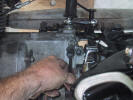
...remove speedometer cable by pulling straight up.
Tuck the speedometer cable up into
the frame where it will not get damaged during engine removal and
replacement. |
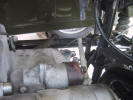
Tie the clutch release arm forward so it is not free
to move during engine removal and replacement. It can easily be bent
or broken if allowed to flop around.
The clutch arm will be needed if
installing a new factory engine. |

Remove the spade connector on the back of the 35A
alternator. The Denso alternator will have two spades. |
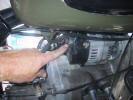
Use a 10 mm wrench to remove the nut holding the
wires to the back of the 35A alternator. The Denso's wiring stud in
located on top of the alternator on the right side, sometimes under
a rubber cover.
Place or tie off these wires to
the frame to prevent damage during engine removal and installation. |
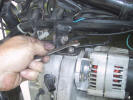
Use a 13 mm wrench to loosen the top engine mount
base nut and remove any wires attached.
Place or tie off these wires to
the frame to prevent damage during engine removal and installation. |
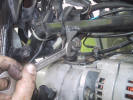
Use a 12 and 13 mm wrench to remove... |
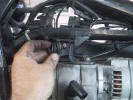
...the top engine mount bolt, washers and rubber
grommets. |
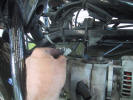
Pull the connect apart for the 12v coil hot wire
going into the front cover. |
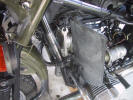
If installed... |
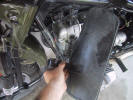
...use a 12 and 13 mm wrench to remove left and right
leg guards. |
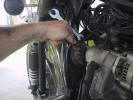
Pull the wires to the horn and use a 12 and 13 mm
wrench to remove the nut holding the horn to frame. Replace nut and
washer on bolt. When remounting horn, it does not matter which wire
goes in which position. |
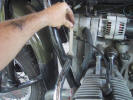
Use a 17 mm wrench to remove the top nut to the
cylinder guard. |
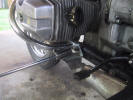
Use a 19 mm socket and long extension to remove the
front left engine mounting bolt nut. This nut secures the bottom of
the cylinder guard also. |
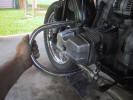
Remove the cylinder guard and put the 17 mm nut back
on the top mount of the guard. |
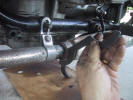
Use the Ural tool kit pin spanner to loosen the
exhaust collar nut on each exhaust. |
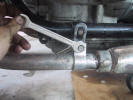
Using a 12 and 13 mm wrench, loosen both the left &
right exhaust header clamps. |
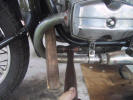
Use a dead blow hammer or block of wood and hammer to
tap the exhaust out of the cylinder head.
2006 year model and newer heads
have bolt on header pipes. |
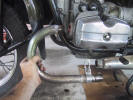
Remove header pipe. |
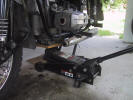
Place a square piece of plywood on a floor jack and
adjust the jack so it just supports the engine. |
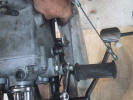
Use a 19 mm wrench to remove the right rear engine
mounting bolt nut and foot peg. |
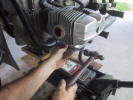
Use a tommy bar and hammer to drive the forward
engine mounting bolt from left to right through the frame. |
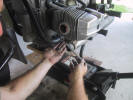
Do not drive the tommy bar all the way in. When you
withdraw the tommy bar, catch the forward engine spacer so you do
not lose it.
Be sure to slip the spacer back in
before re-inserting the engine mounting bolt back through on
reassembly. |
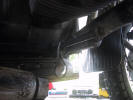
Crawl under the forward end of the sidecar...
Take the hammer and tommy bar with
you. |
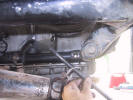
...and withdraw the forward engine mounting bolt and
exhaust header clamp from the frame.
You may need a helper to jiggle the engine to
get the bolt to slide free.
Remember to slip the exhaust clamp
on before reinserting the engine mounting bolt on reassembly. |
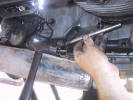
While still under the sidecar, use the tommy bar &
hammer to drive the rear engine mounting bolt from the right to
left. You again may need to adjust the engine with the jack or have
a helper jiggle the engine to get the bolt to move easily. |
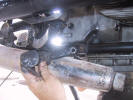
Remove the right foot peg. |
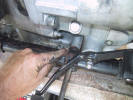
The rear engine mounting bolt can be seen under the
foot shift lever. Note the rear engine spacer and end of the... |
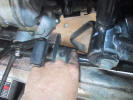
...return spring for the center stand. |
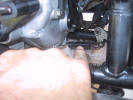
To the right of the center stand spring is the return
spring for the foot brake. All three of these items will fall free
when the rear engine mounting bolt is remove and/or the engine is
moved. |
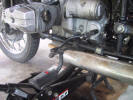
Grasp the left foot peg and twist the rear engine
mounting bolt free of the frame. |
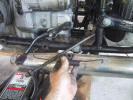
Spacer and center stand spring after falling free.
Do not forget to put the spacer
back in before reinserting the rear engine mounting bolt. Both
spacers go on the left side of the frame. |
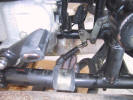
Foot brake return spring has already slipped off its
boss.
On reassembly, use a long pair of
curved needle nose pliers or brake spring pliers to hook the two
springs to their respective bosses. |
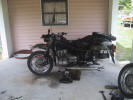
Engine is now supported only by the jack and plywood. |
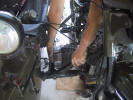
Unless you are built like Boris, you will need two
people to remove the engine from the frame. One person must lean
over the seat and grasp the right cylinder...
Be careful to not pinch your
fingers between the cylinder and sidecar frame!!!! |
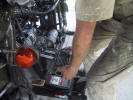
...the other person grabs the left cylinder.
Tilt the left cylinder down enough
to clear the top of the engine from under the top of the frame. Lift
the engine out at a 30 to 45 degree angle until the
engine oil sump is clear of the frame... |
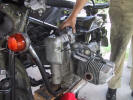
...then rest the sump on the left
side of the frame. The person holding the right cylinder can now
reach through the left side of the frame and grasp the cylinder/gear
box or kick start lever while the other person continues with the
left cylinder... |
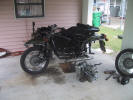
...and finish moving the engine out of the frame.
You should set the engine down on some wood so as
to not damage the sump cooling fins.
Installation is the reverse steps. |